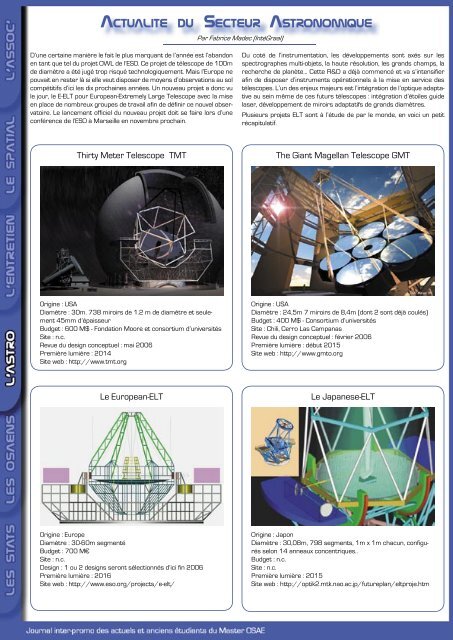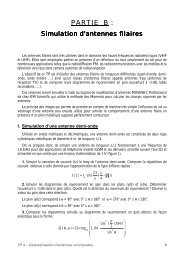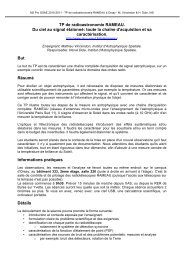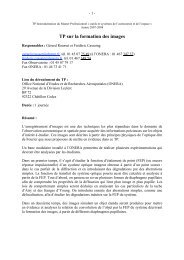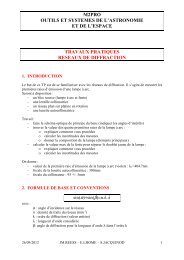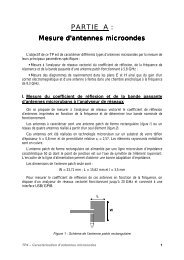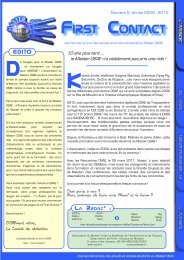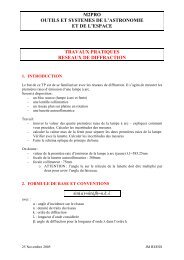ACTUALITE DU SECTEUR ASTRONOMIQUEPar Fabrice Ma<strong>de</strong>c (IntéGraal)D’une certaine manière le fait le plus marquant <strong>de</strong> l’année est l’abandonen tant que tel du proj<strong>et</strong> OWL <strong>de</strong> l’ESO. Ce proj<strong>et</strong> <strong>de</strong> télescope <strong>de</strong> 100m<strong>de</strong> diamètre a été jugé trop risqué technologiquement. Mais l’Europe nepouvait en rester là si elle veut disposer <strong>de</strong> moyens d’observations au solcompétitifs d’ici les dix prochaines années. Un nouveau proj<strong>et</strong> a donc vule jour, le E-ELT pour European-Extremely Large Telescope avec la miseen place <strong>de</strong> nombreux groupes <strong>de</strong> travail afin <strong>de</strong> définir ce nouvel observatoire.Le lancement officiel du nouveau proj<strong>et</strong> doit se faire lors d’uneconférence <strong>de</strong> l’ESO à Marseille en novembre prochain.Du coté <strong>de</strong> l’instrumentation, les développements sont axés sur lesspectrographes multi-obj<strong>et</strong>s, la haute résolution, les grands champs, larecherche <strong>de</strong> planète… C<strong>et</strong>te R&D a déjà commencé <strong>et</strong> va s’intensifierafin <strong>de</strong> disposer d’instruments opérationnels à la mise en service <strong>de</strong>stélescopes. L’un <strong>de</strong>s enjeux majeurs est l’intégration <strong>de</strong> l’optique adaptativeau sein même <strong>de</strong> ces futurs télescopes : intégration d’étoiles gui<strong>de</strong>laser, développement <strong>de</strong> miroirs adaptatifs <strong>de</strong> grands diamètres.Plusieurs proj<strong>et</strong>s ELT sont à l’étu<strong>de</strong> <strong>de</strong> par le mon<strong>de</strong>, en voici un p<strong>et</strong>itrécapitulatif.Thirty M<strong>et</strong>er Telescope TMTThe Giant Magellan Telescope GMTCrédits SALT (salt.ac.za)Origine : USADiamètre : 30m. 738 miroirs <strong>de</strong> 1.2 m <strong>de</strong> diamètre <strong>et</strong> seulement45mm d’épaisseurBudg<strong>et</strong> : 600 M$ - Fondation Moore <strong>et</strong> consortium d’universitésSite : n.c.Revue du <strong>de</strong>sign conceptuel : mai 2006Première lumière : 2014Site web : http://www.tmt.orgOrigine : USADiamètre : 24,5m 7 miroirs <strong>de</strong> 8,4m (dont 2 sont déjà coulés)Budg<strong>et</strong> : 400 M$ - Consortium d’universitésSite : Chili, Cerro Las CampanasRevue du <strong>de</strong>sign conceptuel : février 2006Première lumière : début 2015Site web : http://www.gmto.orgLe European-ELTLe Japanese-ELTOrigine : EuropeDiamètre : 30-60m segmentéBudg<strong>et</strong> : 700 M€Site : n.c.Design : 1 ou 2 <strong>de</strong>signs seront sélectionnés d’ici fin 2006Première lumière : 2016Site web : http://www.eso.org/projects/e-elt/Origine : JaponDiamètre : 30,08m, 798 segments, 1m x 1m chacun, configurésselon 14 anneaux concentriques..Budg<strong>et</strong> : n.c.Site : n.c.Première lumière : 2015Site web : http://optik2.mtk.nao.ac.jp/futureplan/eltproje.htm
'OHANALE PROJET ‘OHANAPar Guillaume Denby Wilkes (Stardust), ces quelques l<strong>et</strong>tres décrivent un proj<strong>et</strong> astronomique très ambitieux : Optical Hawaiian Array for Nanoradian Astronomy. Ce proj<strong>et</strong>a l’ambition <strong>de</strong> réunir sept grands télescopes du Mauna Kea pour les utiliser en configuration interférométrique. En eff<strong>et</strong>, ‘OHANA signifie familleen hawaiien.Parmi les télescopes participants à ce proj<strong>et</strong>, quatre ont <strong>de</strong>s miroirs <strong>de</strong> diamètre <strong>de</strong> huit ou dix mètres : Gemini North, Subaru <strong>et</strong> Keck-I, Keck-II.Les trois autres sont <strong>de</strong> classe quatre mètres : le CFHT (Canada-France-Hawai’i Telescope), l’IRTF (InfraRed Telescope Facility) <strong>et</strong> l’UKIRT (UnitedKingdom InfraRed Telescope).Principe <strong>et</strong> application du proj<strong>et</strong> ‘OHANAEn matière d’observation astrophysique, plus un instrument a un diamètreimportant, plus sa résolution théorique est bonne (la résolution étantle rapport λ/D entre la longueur d’on<strong>de</strong> d’observation λ <strong>et</strong> le diamètre D<strong>de</strong> la surface collectrice <strong>de</strong> l’instrument). Malheureusement, sur Terre,l’atmosphère limite à une résolution pratique <strong>de</strong> 1 secon<strong>de</strong> d’arc quel’instrument ait un diamètre <strong>de</strong> 1 ou 10 mètres.Pour s’affranchir <strong>de</strong> c<strong>et</strong>te limitation atmosphérique, <strong>de</strong>ux techniquessont utilisées : l’optique adaptative (que nous n’abor<strong>de</strong>rons pas ici) <strong>et</strong>l’interférométrie. On le sait, c<strong>et</strong>te <strong>de</strong>rnière consiste à observer un mêmeobj<strong>et</strong> avec plusieurs instruments <strong>de</strong> façon simultanée. Pour obtenir <strong>de</strong>simages, il faut recombiner les faisceaux issus d’au moins trois instruments.Dans le but <strong>de</strong> compenser la différence <strong>de</strong> marche entre cesfaisceaux, on utilise <strong>de</strong> longues lignes à r<strong>et</strong>ard. La correction en quasitemps réel <strong>de</strong>s perturbations atmosphériques se fait quant à elle dansun <strong>de</strong>rnier système : les lignes à r<strong>et</strong>ard rapi<strong>de</strong>s.Pour un interféromètre, le pouvoir <strong>de</strong> résolution <strong>de</strong>vient le rapport entrela longueur d’on<strong>de</strong> d’observation λ <strong>et</strong> la base B entre les instruments.Dans le cas d’ ‘OHANA qui observe dans le proche infrarouge (λ = 25 µm)avec une distance entre les télescopes Subaru <strong>et</strong> Gemini B = 756 m, onobtient une résolution <strong>de</strong> 4,5.10 -4 secon<strong>de</strong> d’arc. Avec c<strong>et</strong>te résolution,les scientifiques espèrent pouvoir observer, par exemple la partie centrale<strong>de</strong>s galaxies abritant un trou noir supermassif (quelques 10 6 massessolaires) ou bien l’environnement proche <strong>de</strong>s étoiles susceptiblesd’abriter un système extrasolaire.Les interféromètres actuels utilisent <strong>de</strong>s miroirs pour gui<strong>de</strong>r les faisceaux.Le premier inconvénient est la perte d’intensité, donc <strong>de</strong> signal,due à la diffraction. De plus, la complexité <strong>de</strong> leurs systèmes <strong>de</strong> miroirssont très dimensionnant <strong>et</strong> restent un point dur pour <strong>de</strong>s interféromètresà gran<strong>de</strong>s bases.La force du proj<strong>et</strong> ’OHANA est <strong>de</strong> remplacer ces miroirs par <strong>de</strong>s fibresoptiques. Ceci perm<strong>et</strong> <strong>de</strong> s’affranchir <strong>de</strong> la perte <strong>de</strong> signal par diffraction<strong>et</strong> autorise la réalisation d’interféromètres à gran<strong>de</strong>s bases. Autre force,relativement faciles à installer, ces fibres perm<strong>et</strong>tent <strong>de</strong> relier en mo<strong>de</strong>interférométrique <strong>de</strong>s télescopes qui à la base n’étaient pas prévu pourc<strong>et</strong>te utilisation.Encore faut-il prouver la faisabilité technique d’un tel système en conditionréelle : c’est chose faite <strong>de</strong>puis le <strong>de</strong>rnier run d’ ’OHANA en juin2006.Le Mauna Kea avec les télescopes Subaru, Keck-I <strong>et</strong> Keck-IIAspects techniques : premières lumières d’ ’OHANALe run <strong>de</strong> juin visait à recombiner les signaux <strong>de</strong> Keck-I <strong>et</strong> Keck-II via <strong>de</strong>uxfibres optiques <strong>de</strong> trois cents mètres <strong>de</strong> long. L’ensemble du système<strong>de</strong> propagation <strong>de</strong>s faisceaux a donc été réinstallé. Les faisceaux sontinjectés dans les fibres optique à la sortie <strong>de</strong>s tables d’optiques adaptatives<strong>et</strong> sont réinjectés dans le systèmes interférométrique juste avantles longues lignes à r<strong>et</strong>ard puis suivent le chemin habituel jusqu’aux différentsdétecteurs.Le problème <strong>de</strong> l’injection <strong>de</strong>s signaux dans les fibres ayant été résolulors <strong>de</strong> précé<strong>de</strong>nts runs, la difficulté était d’obtenir <strong>de</strong>s franges en sortie<strong>de</strong>s fibres. En eff<strong>et</strong>, une fibre n’étant pas parfaitement homogène, il afallu résoudre les problèmes <strong>de</strong> dispersion sur les trois cent mètres,obtenir une transmission convenable <strong>et</strong> résoudre les problèmes <strong>de</strong> polarisation.Ces eff<strong>et</strong>s ont pour conséquence <strong>de</strong> déformer le front d’on<strong>de</strong> <strong>et</strong>au final <strong>de</strong> noyer les franges dans le bruit.Après <strong>de</strong> nombreux rebondissements, toutes ces difficultés ont été surmontées: c<strong>et</strong>te nuit là a été un succès <strong>et</strong> une promesse d’avenir pourle proj<strong>et</strong> ‘OHANA.Nuit du run ‘Ohana : l’équipe concentrée procè<strong>de</strong> au <strong>de</strong>rniers réglages (<strong>de</strong>gauche à droite : Julien Woillez, Jean Guérin, Guy Perrin <strong>et</strong> Takayushi Kotani)Sortie <strong>de</strong>s fibres d’’Ohana <strong>et</strong> injection dans le système interférométriquePerspectives d’avenirFort <strong>de</strong> ce succès, le proj<strong>et</strong> ‘OHANA continue sa progression. La prochaineétape est l’intégration d’une ligne à r<strong>et</strong>ard dans la salle Coudé duCFHT afin d’utiliser celui-ci <strong>et</strong> Gemini en configuration interférométrique.‘OHANA perm<strong>et</strong> dès à présent d’imaginer <strong>de</strong>s interféromètres travaillantdans l’infrarouge <strong>de</strong> taille kilométrique grâce aux fibres optiques.


